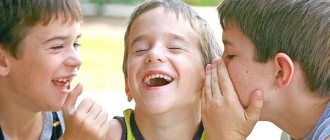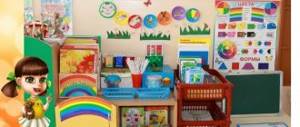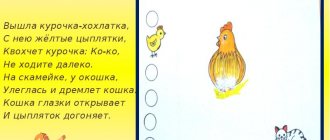Types of fairy tales
Fairy tales can be divided into three types. Telling about animals, showing the life of people, demonstrating magic.
Tales about animals, their oldest roots go back to the depths of Ancient Rus'. The images of kolobok, turnip, fox and bunny are very vividly presented here. These images and manifestations of characters teach the understanding of good and evil.
Fairy tales telling about the life of people are very close to modern realities; there is always something to learn from them.
Fairy tales are a whole world in which good and evil are expressed through the manifestation of the magic of witchcraft. In such stories, a character in the person of a charismatic hero takes upon himself the responsibility of saving people, and sometimes even the whole world.
Heroes do not act alone; as a rule, kind-hearted people help him. While reading, the child sees how important it is to come to the rescue in order to unite in the desire to defeat evil.
Types of “therapeutic” fairy tales
- First of all, these include folk tales, which, thanks to the accessibility and simplicity of the plot, instill morality in the child. These are “Kolobok”, “The Wolf and the Seven Little Goats”, “Ryaba Hen”, “Swan Geese”, “Turnip”, “Masha and the Bear”.
- Another example of fairy tale therapy for preschoolers is the famous works of such authors as Alexander Pushkin, Hans Christian Andersen, Charles Perot, Pavel Bazhov.
- Psychotherapeutic fairy tales have a happy ending, but they make the child think - this leads him to personal growth.
- Didactic - contribute to the child’s acquisition of new knowledge by animating initially abstract numbers and letters for him.
- Psychocorrectional - have an unobtrusive effect on the behavior of a preschooler.
- Meditative – form the child’s idea of existing positive models of relationships with other people and the world around him.
- With the help of diagnostic fairy tales, a specialist determines whether a child has a problem and the sources of its occurrence.
Folk tales and their role in general and speech development
Tales are actively used in teaching children creative retelling.
The kids enthusiastically come up with their own stories, analyze the text, and create creative performances. Having reached the age of six, children have excellent speech abilities, they can easily fantasize and come up with their own compositions when presenting them in public.
You can highlight such qualities as free communication, the ability to compose a complex sentence, correctly combine and pronounce long phrases.
Many children, even from a very early age, have a craving for verbal creativity, which they express in different ways. Some people are great at formulating an essay and telling it, while others have a bit of a difficult time with it, but everyone loves building fantasy worlds. Therefore, it is worth thinking in advance about what books to purchase to make speech development lessons interesting and productive.
To develop speech, it is better to start with short fairy tales with a positive plot and simple presentation in order to arouse interest and win the child’s attention. When children try on any character from a story and remake the plot, their analytical mind progresses.
Subsequently, different aspects of the personality develop, moral qualities are developed, and intelligence grows. This contributes to the emergence of positive character traits.
Speech development
Undeveloped speech is becoming an increasingly serious and pressing problem of our time. Cheap modern literature, a decline in the level of culture, and the primitive language of cartoons and commercials contribute to this. In this regard, modern science is faced with the task of finding new forms of education and training of children that form the prerequisites for their comprehensive development. The development of the child’s literate speech comes to the fore in this process. It is worth noting that the child’s intellectual growth depends on the level of development of speech abilities, so this problem needs to be given serious attention. Many scientists, through research, have proven that developing the speech of a preschooler through fairytale therapy is the most effective and accessible way for him to improve his speaking abilities.
The role of fairy tales in the development of speech in preschool children
The personality development of preschool children harmoniously correlates with the successful mastery of well-constructed and logically verified speech. A fairy tale is a fantastic environment where situations require the manifestation of independence, creativity, and the child’s control of his emotional reactions.
Many 5-year-old children have a low level of speech development. The transmission of emotional states, abilities associated with artistic expression, intonation or poor quality sound reproduction also suffer.
Fortunately, these problems are being eliminated. Playing a fairy tale allows you to activate different aspects of the speech apparatus, improve vocabulary, grammatical structure, develop the ability to conduct a monologue and be able to enter into dialogue, and work on the sound of speech.
Possibilities of Russian folk tales in the development of children's speech
Thanks to humor, lively, rich expression conveying bright colorful images, Russian fairy tales help develop coherent speech. The works are quite simple in presentation, the children easily analyze and form their opinions regarding the heroes and their actions.
After reading a fairy tale, ask what attitude arose towards the heroes, why the heroes are the way they are, why they behave this way. By answering these questions, the guys will formulate their thoughts, pronounce sentences, thereby training their speech.
An important role in the development of speech is played by sound-letter analysis, which children encounter in the fairy tales Gingerbread Man and Turnip. The characters in these fairy tales appear sequentially, and as the plot develops, this sequence is repeated, so children participate in the development of sound-letter analysis.
Theater production is very effective in developing speech. Table theater, finger theater or shadow theater, by participating in such productions the child will become more relaxed, work on his intonation, facial expressions, and voice power.
Using fairy tales, you can get great results in the development of speech, the structure of the syllable, phonemic perception improves, the articulatory apparatus, lexical and grammatical categories, and sound differentiation develop.
Development of coherent speech in children of senior preschool age through a fairy tale
Development of coherent speech in older children through a fairy tale
Title: Development of coherent speech in preschool children through a fairy tale. Goal: Creating favorable conditions for organizing the correctional educational process for the development of coherent speech in preschool children. Objectives: - develop coherent speech in children in accordance with their age and individual characteristics; - ensure the development of the abilities and creative potential of each child as a subject of relationships with himself, with other children, and adults; - promote the integration of training and education into a holistic educational process. DEVELOPMENT OF CONNECTED SPEECH IN PRESCHOOL CHILDREN THROUGH A FAIRY TALE . A fairy tale is an amazing phenomenon of folk art. Simple and uncomplicated in appearance, it is interesting to a small child. A child enters the world of fairy tales in very early childhood, as soon as he begins to speak. Currently, it is difficult to find a better way to raise children than by introducing them to oral folk art from early childhood. The fairy tale expands the life experience of the child, educates moral lessons of compassion, selflessness, love for all living things, empathy, the idea of morality, justice, and the need to fight evil. Russian folk tales develop figurative thinking and expressiveness of speech, as they are rich in lyrical inserts, vivid character characteristics, dialogues, and rhythmic melody. Listening to fairy tales, the child learns the sounds of his native speech and its melody. The older the child becomes, the more he feels the beauty and accuracy of native Russian speech, and is imbued with its poetry. The little person not only comprehends the Russian language, but also gradually becomes familiar with folk wisdom. The world of a fairy tale is wonderful, it is unique and inimitable in its capabilities. Fairy tales for children are cyclical in nature - repeated repetition of the plot with minor changes. This feature of fairy tales allows the child to remember it better and stimulates interest in the word. Fairy tales are an effective means of developing speech in preschool children. Before reading fairy tales, propaedeutic work is carried out, the purpose of which is to organize the attention of children and prepare them for perception. This is guessing riddles about the characters of the work, clarifying individual words or phrases contained in the text, and demonstrating corresponding pictures. The texts of fairy tales are read to children twice, at a slow pace. When reading again, the technique of children completing individual sentences is used. Analysis of the content of fairy tales is carried out in a question-and-answer form; the questions are aimed at highlighting the main points of the plot action, their sequence, identifying the characters and the most significant details of the story. Each organized educational activity, including work with a fairy tale, is accompanied by various kinds of visual and gaming material. “Living a fairy tale,” children learn to overcome barriers in communication, subtly feel each other, and find adequate bodily expression for various emotions, feelings, and states. A fairy tale serves as the best material for a dramatization game. Playing a fairy tale helps to activate different aspects of children’s speech: - vocabulary; - grammatical structure; - dialogical and monologue speech; - improving the sound aspect of speech. Children learn to retell, write creative stories, compose fairy tales, make up fairy tales and tall tales. Classes to familiarize yourself with fiction develop children's artistic taste, develop imagination, as well as the ability to feel and understand the expressive means of their native language. Possibilities of Russian folk tales in the development of children's speech. Thanks to humor, lively rich expressions conveying bright colorful images, Russian fairy tales help to develop coherent speech. The works are quite simple in presentation. Children easily analyze and form their opinions regarding the characters and their actions. After reading the fairy tale, ask what attitude arose towards the heroes, why the heroes are the way they are, why they behave this way. By answering these questions, the guys will formulate their thoughts, pronounce sentences, thereby training their speech. Theater production is very effective in developing speech. Table theater or finger theater. By participating in such productions, the child will become more relaxed and will work on his intonation, facial expressions, and voice strength. Using fairy tales, you can get great results in the development of speech, the structure of the syllable, phonemic perception improves, the articulatory apparatus, lexical and grammatical categories, and sound differentiation develop. The role of fairy tales in the development of oral speech. Fairy tales help develop correct oral speech; reading them allows you to increase your vocabulary and build a dialogue correctly. The expressiveness of the language and its accuracy immediately become obvious, this is humor and lively figurative expressions. In the tales, the full power of the verbal creativity of the Russian people is very clearly manifested, brightness, magnificent images, the need to pronounce the same speech forms - all this puts fairy tales in first place in the development of oral speech. Through a fairy tale, a child learns many new words and figurative expressions. His speech becomes emotionally rich. And so , for retelling to have an effect on speech development, the following rules must be observed: - the child needs to fully understand the text read;
- convey the literary text as fully as possible, - avoid violating the logic of the story; — use of words and phrases in the author’s original performance; — use of correct synonyms; - use the correct rhythm; - maintain consistency. The closer to the source of the work, the better the quality of the retelling. In the process of retelling, the child must be stopped if he gets too carried away and adds invented details and forgets about important points. To start retelling, you need to read the fairy tale expressively. Emotional presentation will allow you to better understand and perceive the text. Accordingly, the retelling will be easier and more effective. Examples of games using fairy tales
“Stepping into a fairy tale” Purpose: Consolidating knowledge of fairy tales, developing speech, memory, and thinking. The teacher says the name of the fairy tale, and the child walks and names a hero from this fairy tale for each step. “Help the hero find his fairy tale” Goal: Consolidating knowledge of fairy tales, developing speech, memory, attention. Scenes from 2-3 fairy tales are laid out on the tables. The teacher gives the children pictures depicting fairy-tale characters, and the children match each story with their own fairy-tale hero. “Actions of the hero” Purpose: To teach children to list all the possible actions of a fairy-tale hero. Teach children to draw analogies in the actions of heroes of different fairy tales. For example, the fairy tale “Kolobok”. The teacher asks the children to name all the actions of the kolobok, saying only verbs: rolled, sang, left, etc. Next, the teacher suggests remembering the heroes who would perform the same actions in other fairy tales. “True - False” Goal: Consolidating knowledge of fairy tales, developing coherent speech, and the ability to listen carefully to each other. The teacher reads the sentence, and the children must agree or disagree. For example: Grandfather by the turnip, granddaughter by the grandfather, they pull, pull, they can’t pull it out... The granddaughter called the mouse... The chicken laid an egg, not a simple one, but a porcelain one... “Good or bad” Goal: To develop the ability to find positive and negative aspects in any object, situation . For example: The mouse came running to pull out the turnip. This is good. Why? (The mouse helped pull out the turnip.) This is bad. Why? (The cat could have eaten the mouse). “Fairytale words” Purpose: To teach children to list different variants of words and phrases based on a given characteristic. The teacher invites the children to remember and say all the spells that they know from fairy tales (Sim-sim, open the door; Sivka-burka, prophetic kaurka... etc.) then list all the words with which the fairy tale begins (Once upon a time in a certain kingdom, in ancient times...etc.). “False alternative” Goal: Development of attention and coherent speech. The teacher asks questions using the words “either-or”, but none of the proposed answers are correct. For example: Who laid the golden egg - the duckling or the chicken? Who crushed the tower - a hare or a wolf? Who helped pull the turnip - grandpa or grandma? “What first, what then” Purpose: To teach how to convey the correct temporal and logical sequence of a story using cards from the mnemonic table. The child is asked to lay out the cards and make up a story. Cards allow you to accurately convey the plot, from beginning to end. A fairy tale for a child is a game, magic, maintaining a playful, truly fairy-tale atmosphere necessary for a child. A little fairy tale, a little miracle , and you already see a happy baby in front of you. A fairy tale not only increases cognitive interest and motivation for learning activities, but also encourages the child to analyze, reason, look for cause-and-effect relationships, and draw conclusions. Therefore, it is no coincidence that today fairy tales are used by speech therapists, providing an integrated approach to the development of a child.
We recommend watching:
Summary of a lesson on speech development for the senior group Consultations for preschool teachers. Using oral folk art for speech development Speech development in preschoolers through play Critical thinking technologies for speech development in preschoolers
Similar articles:
Games for the development of speech breathing in the middle and senior groups
Speech development in children 3-4 years old with developmental disabilities based on Suteev’s fairy tales
Stages of speech development in a child
Tasks in pictures for speech development for children 3-5 years old
Exercises for speech development in children 4-5 years old
The role of fairy tales in the development of oral speech
Fairy tales help develop correct oral speech; reading them allows you to increase your vocabulary and build a dialogue correctly. The expressiveness of the language and its accuracy immediately become obvious, this is humor and lively figurative expressions.
In the legends, the full power of the verbal creativity of the Russian people is very clearly manifested: crystal clarity, brightness, magnificent images. the need to pronounce the same speech forms - all this puts fairy tales in first place in the development of oral speech.
Through a fairy tale, a child learns many new words and figurative expressions; his speech becomes emotionally rich. When analyzing the text, the child uses metaphors and epithets, this helps to verbally express his attitude to the history of the material read.
To build the foundations of oral speech, it is necessary to undergo special training.
For example L.B. Fesyukova recommends making a rhyme from two words blacksmith-daring, and then moving on to the chain of rhymes and creating a couplet. You can also play the game “A word from each” where you need to make up a long common sentence.
The most important, says L.B. Fesyukova, education of sensitivity to words. To do this, she suggests finding affectionate, beautiful, sad words in the work.
Come up with a long and funny word Analyze words that have the same spelling but different semantic meanings. For example, flour-flour, where the meaning depends on the placement of emphasis.
Voice the word using only consonants and invite the children to determine its full sound.
Come up with a new name for fairy tales so that it matches the original idea.
A fairy tale develops cognitive processes in a child, and unfavorable development is corrected. The level of coherent speech increases significantly, time and space, man and nature, courage, perseverance and other manifestations of life become accessible to understanding by young children. The plot of fairy tales attracts attention and maintains interest during the lesson.
This is especially important for children with unstable psycho-emotional background; such children find it easy to concentrate and quickly grasp the material. Learning becomes an exciting game together with the heroes of the story. The child gains a clear understanding of the world around him, his horizons increase and mental processes develop.
Summary of a lesson in the senior group on the topic “Meeting a fairy tale”
Program content:
- teach to comprehend the actions of fairy-tale heroes;
- develop skills of coherent speech;
- practice recognizing fairy tales and solving moral and semantic problems;
- develop the ability to express emotions through facial expressions and expressive movements;
- promote the development of fine motor skills and creative imagination;
- through the formation of moral qualities, to cultivate kindness and responsiveness.
Progress of the lesson
Educator (V.). Guys, we have long become friends with fairy tales. And I know your dream: to be in a fairy tale, at least for a short time.
Therefore, I propose to go to the distant kingdom to meet unusual fairy-tale characters there. And here is the fabulous magic door.
Music from the fairy tale “Pinocchio” sounds.
Q. Well, guess what fairy tale hero will help us open the magic gate? Look how flowery the lawn is. Only the flowers drooped, their heads drooped. How can we help them? (Children's answers)
Q. Your good wishes made my flower open. The fairy tale “Thumbelina” lives in my flower. You, too, go to the flower, unfold the petals, and find the fairy tale there too. Tell me, what fairy tale?
(In my flower live the fairy tales “Sister Alyonushka and Brother Ivanushka”, “The Three Little Pigs”, “Fox with a Rolling Pin”, “Geese-Swans”, “Frog Princess”, “Fox, Hare and Rooster”, etc.)
Q. Where should we go next? What in fairy tales helps you find your way? (arrow, running boots, bullseye...).
Miracles happen in fairy tales, heroes lose their way,
We will sit down on a stump and the ball will help us.
Let's draw it.
We draw curls, we get balls,
One turn, two turns, we get our ball.
Q. Who will tell us about his ball? (Children's stories).
Our journey will be more fun with magic balls, because you told everything about them in a very interesting way. Close your eyes together, in a moment we will be in a fairy tale.
Scary music sounds.
Q. Where are we?
There is a hut in the dark forest, standing backwards.
A difficult old lady lives there, Grandma Yaga lives.
(Children portray Baba Yaga, and then beautiful, well-mannered children).
Q. You would, of course, like to see yourself beautiful, smiling in the mirror. But for this we need to collect the mirror that the queen broke. What fairy tale was this in? (“The Tale of the Dead Princess and the Seven Knights”).
A mirror appears. The children look and smile. (The tower is standing).
V. I want only good, kind heroes to live in my little house. Help me. There are different hats here. And you choose hats only from good heroes of different fairy tales. Anyone who chooses a hat can immediately move into our little house.
V. Oh, how many tenants have settled in the tower. Why is Little Red Riding Hood here? Why do you think that your hero should live in a mansion? (Answers roughly sound like this: “Cinderella is kind because she ...”)
You are so smart, that’s why you were able to enter the distant kingdom, the thirtieth state, to meet unusual heroes there.
Music is playing. The cat comes out.
Cat. I wonder how you found me?
V. We visited fairy tales and talked about many fairy tale heroes.
Cat. I have stars. They are small, like you. But a person grows, does good deeds, and then the stars sparkle with joy, grow big and grow forever. Let's take the stars, decorate the starry sky with them and a real miracle will happen.
The garland lights up and music sounds.
Appendix 2
Development of coherent speech in preschoolers through fairy tales
Practical methods for developing coherent speech:
Create new circumstances for the heroes. The main characters are the same, but the circumstances are completely different from the fantastic and coastal ones in current reality.
For example, Vanka-Vstanka, the director of a bakery factory, or Koschey, the immortal lord of the moon. Children will be happy to invent new circumstances and situations with their favorite characters, developing their own imagination.
Inversion of the text is used if the fairy tale is familiar. In this method, a mistake is made so that the children can correct it. For example, the deliberate mistake of calling Little Red Riding Hood yellow.
Tell it in a new way. Here you can work not only on the development of speech, but also on the development of the child’s feelings. For example, propose to find a humane way to re-educate the stepmother and lazy daughter from the legend of Morozko.
The rescue. Imagine situations with different possible rescue solutions. Children will compose stories that will contribute to the development of coherent speech
Come up with an ending. It is necessary to offer to come up with ending options. The method develops logic, conducts correct analysis and completes the thought, and uses vocabulary.
Working on coherent speech should be done periodically. Be sure to start before the age of 6-7 years. Children will develop their vocabulary and learn to use linguistic means of expression; speech will become meaningful and logical.
Goals and principles of speech fairy tale therapy
The goal of such work is always the use of fairy tales as a means of developing coherent speech in preschoolers. It is possible to achieve this goal by analyzing the works of domestic and foreign scientists on this topic, the practical use of existing methods for solving problems of speech development, followed by identifying the effectiveness of each stage of the work done.
Fairytale therapy for preschoolers should be a process that is based on the following fundamental principles:
- Correction must be approached gradually, starting with simple exercises and ending with more complex ones.
- In the process of work, it is necessary to create conditions that will help the child to self-realize thanks to the knowledge and experience gained.
- A necessary condition for quality work is also the presence of integrability and continuity. In other words, one cannot limit oneself to the activities of one specialist; both parents and educators should come to his aid.
Retelling
Retelling classes begin already at kindergarten age; by doing this orally, perceiving the fairy tale in his own speech, the child strengthens his speech development. It is necessary to meaningfully, emotionally, perceive your own retelling; it is at these moments that creative activity manifests itself!
The process of retelling makes the understanding of the literary word more profound, and the images appear close and understandable. Stories for oral storytelling should evoke a lively response, be short and expressive.
The best material is legends about animals; they have a dynamic plot and clear characteristics of the heroes.
And so that the retelling has an effect on the development of speech, the following rules must be observed:
- the child needs to fully understand the text read;
- Convey the literary text as fully as possible, avoid violating the logic of the story;
- the use of words and phrases in the original performance of the author;
- using correct synonyms;
- use the correct rhythm;
- long-term sex;
- maintain consistency.
The closer to the source of the work, the better the quality of the retelling. In the process of retelling, the child must be stopped if he gets too carried away and adds invented details and forgets about important points. To begin the retelling, you need to read the fairy tale expressively; the emotional presentation will allow you to better understand and perceive the text, and accordingly the retelling will be easier and more effective.
MAGAZINE Preschooler.RF
Using various techniques for working with fairy tales for the development of speech in preschool childrenCompiled by: teacher of MADOU No. 51 in Syktyvkar “Golden Fish” Tatyana Andreevna Torlopova.
Mastering the native language is an important acquisition for a child in preschool childhood. Monitoring results indicate that the number of preschool children with significant impairments in speech development has recently increased. At home, the child spends very little time in the company of adults and rarely listens to stories and fairy tales that parents read. Therefore, by the time children enter school, many problems arise (poor vocabulary, use of incorrect grammatical forms in speech, lack of coherent speech, etc.) In this regard, one of the most important tasks for preschool educational institutions is the speech development of preschool children.
In my work, I chose a fairy tale as one of the means of developing speech.
A fairy tale is the oldest genre of oral folk art. The world of fairy tales is amazing and unique. Good and evil coexist in this world. The fairy tale teaches children moral standards of behavior. Children draw a lot of knowledge from fairy tales. But, unfortunately, fairy tales are not presented to preschoolers in enough variety, mainly through reading.
Therefore, I want to talk about methods and techniques for working with fairy tales.
Visual method.
Techniques:
- Examination of illustrations, toys;
- Elementary dramatizations;
- Watching videos;
- Exhibition design;
Verbal method.
- reading works
- content questions
- retelling
- memorization
- listening to audio recordings
Game method.
- Elements of staging;
- Dramatization games;
- Didactic games;
- Theater games;
- Using different types of theater.
Learn more about some of the techniques.
Didactic game "Wonderful bag" . It contains items from fairy tales. Tasks: name which fairy tale the object is from, tell an excerpt, etc.
Didactic game “Guess which fairy tale the expression is from .
Scene pictures. Tasks:
a) find the error;
b) put them in order;
c) what you missed.
Dramatization.
It is difficult for children to tell the whole story. The basis of acting is theatrical sketches. You can use the following tasks: “Who moves like that” , “How the bunny cried” .
Conversations based on content.
1. Techniques that help to understand the content of the work:
- Questions.
They must be heterogeneous. Some questions help children characterize the characters of the fairy tale. For example, what kind of bunny? (weak, gullible, naive, kind). Other questions help to understand the idea of the work (Why did the hero do this, was it right). It is also necessary to ask questions to help children understand the features of the genre (Why is this work called a fairy tale? What is fiction in it? What magical objects are found in the fairy tale?)
- Looking at illustrations. The teacher offers an illustration depicting an ordinary kolobok and asks the question: “What was the kolobok like in the fairy tale? Why not? What should a fairy tale bun look like?” . You can offer two illustrations for comparison. For example, an ordinary stove and a magic one.
- Verbal sketches. For example, what kind of witch is in the fairy tale, what are her eyes, facial expression, etc.
2. Techniques that promote understanding of the language of a fairy tale.
- Repeated reading of passages from the text at the request of children. With such reading, the child more fully perceives the merits of the work and notices the means of expression.
- At the request of the teacher, children remember the funniest episode, the saddest, the most terrible, etc., retell the descriptions or actions of the characters.
- The teacher recalls one of the episodes and asks to tell us more about it.
Working on a fairy tale provides great opportunities for speech development. The rich figurative language of the fairy tale helps the child expand his vocabulary and form the grammatical structure of speech. In addition, preschoolers become familiar with the rich cultural heritage of the Russian people. Consequently, a fairy tale is an effective means for the development of speech, and in order for this means to produce results, they must be used in their work to the fullest extent, using various techniques.
| Next > |
Writing fairy tales
Imagination is of great importance in the development of preschoolers, but unfortunately today the level of imagination in many is quite low.
When a child is asked to compose a story, he uses past experience to do this, this indicates that the level of imagination is at the first or second level. It’s sad, but only some guys have their own inner vision, using which they cope perfectly with the task of composing a story.
A child with a well-developed imagination has excellent speech and original ideas, translating them into fairy tales. To write well, you need to have coherent speech, that is, be able to conduct a monologue.
In turn, in order to conduct a monologue you need to have accumulated experience from life and literature. Analytical skills and the ability to think through your story in advance must also be developed.
When learning to write, it is important to choose a plot that will encourage you to come up with your own story. The story should be clear and understandable, including simple descriptions.
The plot must be chosen based on the level of speech development and experience of the child; it is very important to touch upon the moral aspect and aesthetic perception. Help your child during the writing process, guide your child through the story by asking questions, this will help stick to the theme and logical flow of the story.
Basic steps
While acting out the fairy tale, children get used to their roles and become interested in events. It is important that each child independently pronounces the text he has prepared. Various parts of the work will help you to carry out many useful exercises.
In the process of storytelling, a lot of vocabulary work is carried out, the “Admiring” exercise, which consists of admiring a fly, develops empathy and noble feelings. Children find it interesting to conduct a dialogue, and the poetic form of presentation of the work helps to consolidate the variety of words and expressions in their memory.
While playing the fairy tale, you can also have a conversation about how you shouldn’t leave a friend in trouble, or conduct articulation exercises, during which the children must show with their emotions how delicious the fly’s jam is. The “Fear” exercise, which must be carried out while a spider is stealing a fly, will teach children to pretend to be scared and will play an important role in the development of facial expressions.
It is also important to make the right “exit” from the fairy tale, ask the children to remember all the important points and explain how the lesson benefited them.






